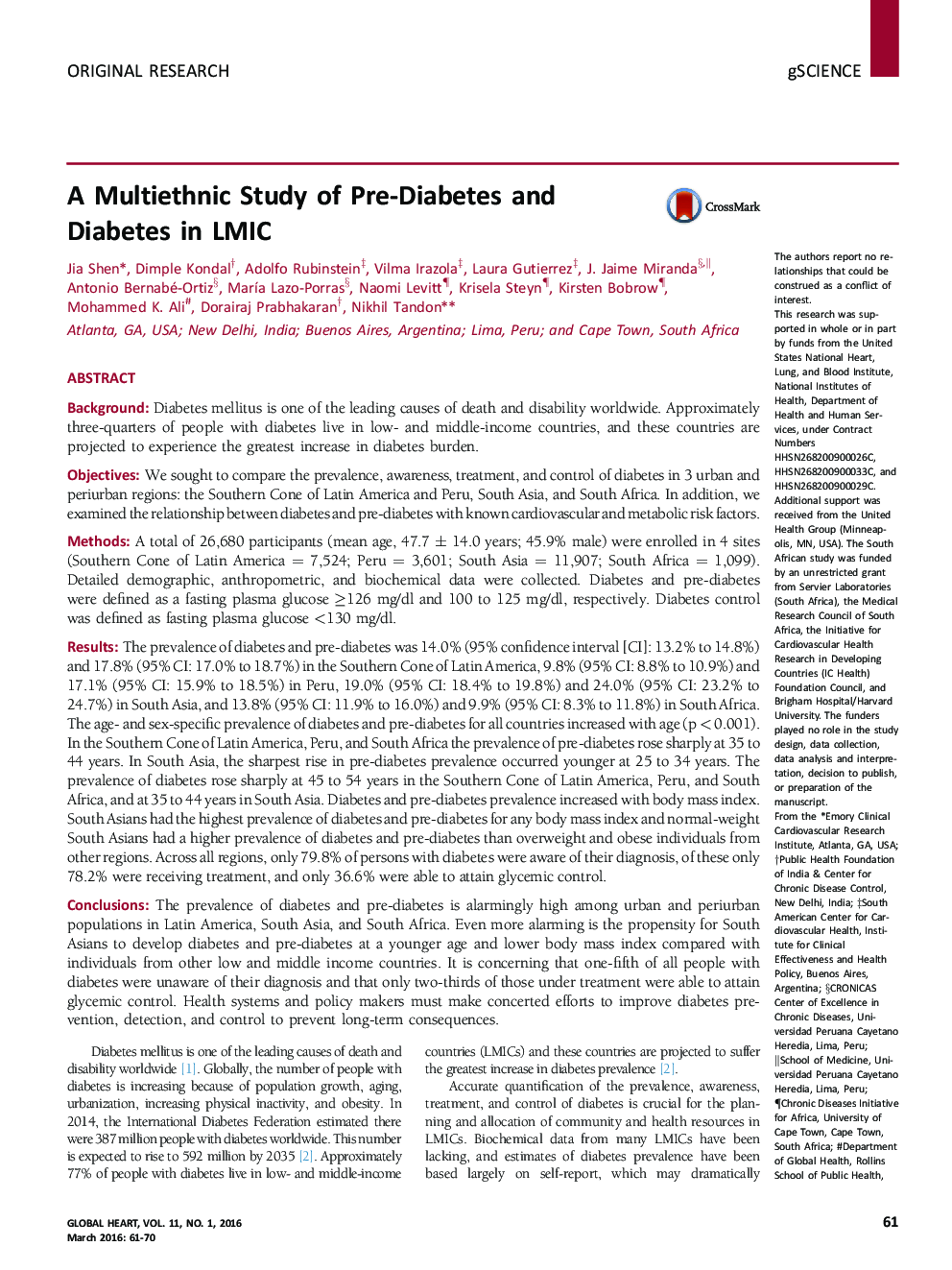| کد مقاله | کد نشریه | سال انتشار | مقاله انگلیسی | نسخه تمام متن |
|---|---|---|---|---|
| 5958658 | 1175621 | 2016 | 10 صفحه PDF | دانلود رایگان |

- The prevalence of pre-diabetes was 17.8% in the southern cone of Latin America, 17.1% in Peru, 24.0% in South Asia, and 9.9% in South Africa.
- The prevalence diabetes was 14.0% in the southern cone of Latin America, 9.8% in Peru, 19.0% in South Asia, and 13.8% in South Africa.
- The prevalence of pre-diabetes and diabetes rose sharply 10 years earlier in South Asia (between 25 and 34 and 35 and 44 years, respectively) than it did in other low-middle income countries.
- South Asians had the highest prevalence of pre-diabetes and diabetes for any body mass index and normal-weight South Asians had a higher prevalence of diabetes and pre-diabetes than overweight and obese individuals from other regions.
- Across all regions, only 79.8% of persons with diabetes were aware of their diagnosis, of these only 78.2% were receiving treatment, and only 36.6% were able to attain glycemic control.
BackgroundDiabetes mellitus is one of the leading causes of death and disability worldwide. Approximately three-quarters of people with diabetes live in low- and middle-income countries, and these countries are projected to experience the greatest increase in diabetes burden.ObjectivesWe sought to compare the prevalence, awareness, treatment, and control of diabetes in 3 urban and periurban regions: the Southern Cone of Latin America and Peru, South Asia, and South Africa. In addition, we examined the relationship between diabetes and pre-diabetes with known cardiovascular and metabolic risk factors.MethodsA total of 26,680 participants (mean age, 47.7 ± 14.0 years; 45.9% male) were enrolled in 4 sites (Southern Cone of Latin America = 7,524; Peru = 3,601; South Asia = 11,907; South Africa = 1,099). Detailed demographic, anthropometric, and biochemical data were collected. Diabetes and pre-diabetes were defined as a fasting plasma glucose â¥126 mg/dl and 100 to 125 mg/dl, respectively. Diabetes control was defined as fasting plasma glucose <130 mg/dl.ResultsThe prevalence of diabetes and pre-diabetes was 14.0% (95% confidence interval [CI]: 13.2% to 14.8%) and 17.8% (95% CI: 17.0% to 18.7%) in the Southern Cone of Latin America, 9.8% (95% CI: 8.8% to 10.9%) and 17.1% (95% CI: 15.9% to 18.5%) in Peru, 19.0% (95% CI: 18.4% to 19.8%) and 24.0% (95% CI: 23.2% to 24.7%) in South Asia, and 13.8% (95% CI: 11.9% to 16.0%) and 9.9% (95% CI: 8.3% to 11.8%) in South Africa. The age- and sex-specific prevalence of diabetes and pre-diabetes for all countries increased with age (p < 0.001). In the Southern Cone of Latin America, Peru, and South Africa the prevalence of pre-diabetes rose sharply at 35 to 44 years. In South Asia, the sharpest rise in pre-diabetes prevalence occurred younger at 25 to 34 years. The prevalence of diabetes rose sharply at 45 to 54 years in the Southern Cone of Latin America, Peru, and South Africa, and at 35 to 44 years in South Asia. Diabetes and pre-diabetes prevalence increased with body mass index. South Asians had the highest prevalence of diabetes and pre-diabetes for any body mass index and normal-weight South Asians had a higher prevalence of diabetes and pre-diabetes than overweight and obese individuals from other regions. Across all regions, only 79.8% of persons with diabetes were aware of their diagnosis, of these only 78.2% were receiving treatment, and only 36.6% were able to attain glycemic control.ConclusionsThe prevalence of diabetes and pre-diabetes is alarmingly high among urban and periurban populations in Latin America, South Asia, and South Africa. Even more alarming is the propensity for South Asians to develop diabetes and pre-diabetes at a younger age and lower body mass index compared with individuals from other low and middle income countries. It is concerning that one-fifth of all people with diabetes were unaware of their diagnosis and that only two-thirds of those under treatment were able to attain glycemic control. Health systems and policy makers must make concerted efforts to improve diabetes prevention, detection, and control to prevent long-term consequences.
Journal: Global Heart - Volume 11, Issue 1, March 2016, Pages 61-70